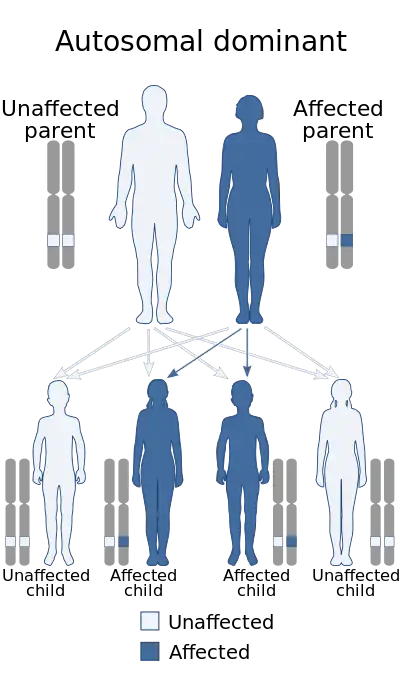2q37 deletion syndrome
2q37 deletion syndrome is a disorder caused by the deletion of a small piece of chromosome 2 in which one or more of 3 sub-bands, 2q37.1, 2q37.2, and 2q37.3, of the last band of one of the chromosome 2’s long arms are deleted.[1] The first report of this disorder was in 1989.[1]
| 2q37 deletion syndrome | |
|---|---|
| Other names | Brachydactyly-intellectual disability syndrome, Albright hereditary osteodystrophy type 3 |
 | |
| 2q37 deletion syndrome is inherited in an autosomal dominant manner | |
Symptoms and signs
The earliest signs and symptoms occur in newborns and consist of hypotonia, but show up in youth as developmental delays, low muscle tone, learning disabilities, being overweight, autism-like symptoms, seizures, eczema, asthma, chest and ear infections, and abnormalities in face, hands, and feet such as brachydactyly.[2][3]
Autism-like symptoms consist of odd obsessions, repetitive behavior, poor use of eye contact, impaired speech, poor understanding of others’ emotions, idiosyncratic use of words or phrases.[3]
People with this disorder also tend to have a characteristic appearance, including prominent forehead, thin, highly arched eyebrows, depressed nasal bridge, full cheeks, deficient nasal alae and prominent columella, thin upper lip, and various minor anomalies of the pinnae.[4]
Heart, brain, gastrointestinal, and kidney problems such as Wilms tumor,[5] and hernias, spinal curvatures, osteopenia, hearing and sight difficulties can also occur.[3]
Diagnosis
Techniques used to diagnose this disorder are fluorescence in situ hybridization (FISH) and microarrays.[3] FISH uses fluorescent dyes to visualize sections under a microscope, but some changes are too small to see.[3] Microarray comparative genomic hybridization (array CGH) shows changes in small amounts DNA on chromosomes.[3]
Treatment
Therapy can help developmental delays, as well as physiotherapy for the low muscle tone.[3] Exercise and healthy eating can reduce weight gain. Treatments are available for seizures, eczema, asthma, infections, and certain bodily ailments.
Prognosis
While only a few adults have been reported with 2q37 microdeletion syndrome, it is predicted that this number will rise as various research studies continue to demonstrate that most with the disorder do not have a shortened life span.[6]
See also
References
- Leroy C.; E. Landais; S. Briault; A. David; O. Tassy; N. Gruchy; B. Delobel; M. J. Grégoire; B. Leheup; L. Taine; D. Lacombe; M.A. Delrue; A. Toutain; A. Paubel; F. Mugneret; C. Thauvin-Robinet; S. Arpin; C. Le Caignec; P. Jonveaux; M. Beri; N. Leporrier; J. Motte; C. Fiquet; O. Brichet; M. Mozelle-Nivoix; P. Sabouraud; N. Golovkine; N. Bednarek; D. Gaillard; M. Doco-Fenzy (Jun 2013). "The 2q37-deletion syndrome: an update of the clinical spectrum including overweight, brachydactyly and behavioural features in 14 new patients". European Journal of Human Genetics. 21 (6): 602–12. doi:10.1038/ejhg.2012.230. PMC 3658200. PMID 23073310.
- Chaabouni M, Le Merrer M, Raoul O, et al. (2006). "Molecular cytogenetic analysis of five 2q37 deletions: refining the brachydactyly candidate region". European Journal of Medical Genetics. 49 (3): 255–63. doi:10.1016/j.ejmg.2005.07.001. PMID 16762827.
- "2q37 deletion syndrome" (PDF). Rare Chromosome Disorder Support Group. Archived from the original (PDF) on 18 May 2015. Retrieved 8 April 2015.
- Falk, R.E. & K. A. Casas (15 Nov 2007). "Chromosome 2q37 deletion: Clinical and molecular aspects". American Journal of Medical Genetics. 145C (4): 357–371. doi:10.1002/ajmg.c.30153. PMID 17910077. S2CID 25719005.
- Viot-Szoboszlai G, Amiel J, Doz F, et al. (1998). "Wilms' tumor and gonadal dysgenesis in a child with the 2q37.1 deletion syndrome". Clin. Genet. 53 (4): 278–80. doi:10.1111/j.1399-0004.1998.tb02696.x. PMID 9650765. S2CID 22222281.
- Emily S Doherty & Felicitas L Lacbawan (3 May 2007). "2q37 Microdeletion Syndrome – RETIRED CHAPTER, FOR HISTORICAL REFERENCE ONLY". 2q37 Microdeletion Syndrome. p. 18. PMID 20301337. Retrieved 8 April 2015.
{{cite book}}:|journal=ignored (help)